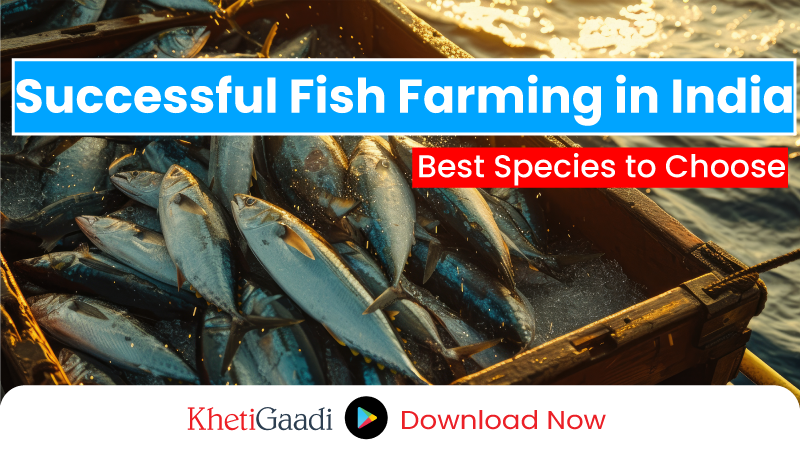Fish farming, also known as aquaculture, has emerged as a vital component of the agricultural sector in India. With the growing demand for fish as a source of protein, fish farming offers immense potential for economic growth and nutritional security. This blog will explore the best fish species for fish farming in India, the scope of fish farming in the country, and the various methods used to cultivate these fish.
Fish farming at a glance
| Aspect | Details |
| Industry Overview | One of the fastest-growing sectors in Indian agriculture; India is the second-largest producer of fish in the world after China. |
| Major Fish-Producing States | Andhra Pradesh, West Bengal, Odisha, Tamil Nadu, Kerala, Gujarat, Karnataka. |
| Types of Fish Farming | Inland aquaculture (ponds, tanks), Brackish water aquaculture, Marine aquaculture. |
| Key Fish Species | Freshwater: Rohu, Catla, Mrigal, Common Carp; Brackish: Shrimp, Scampi; Marine: Sea Bass, Cobia, Pearl Spot. |
| Total Fish Production | Approx. 14 million metric tonnes annually (as of 2024). |
| Key Challenges | Water quality management, disease outbreaks, feed availability and cost, environmental concerns, market volatility. |
| Domestic Consumption | High demand for fish and seafood, with an increasing focus on domestic market expansion and value-added products. |
| Export Markets | Major exports include shrimp and fish to the USA, Japan, European Union, and Southeast Asia; India is a leading exporter of frozen shrimp. |
| Government Schemes | Pradhan Mantri Matsya Sampada Yojana (PMMSY), Blue Revolution Scheme, Fisheries and Aquaculture Infrastructure Development Fund (FIDF). |
| Future Trends | Expansion of sustainable aquaculture practices, increased use of technology (e.g., IoT for monitoring), development of new aquaculture species. |
Overview of Fish Farming
Fish farming_ is the practice of raising fish in controlled environments such as tanks, ponds, or enclosures for commercial purposes. This practice helps meet the increasing demand for fish and fish products, offering an alternative to traditional capture fisheries, which are often unsustainable due to overfishing.
Benefits of Fish Farming
- Sustainability: Fish farming is a sustainable way to produce fish, reducing pressure on wild fish populations.
- Economic Growth: It creates jobs and boosts the economy, particularly in rural areas.
- Nutritional Security: Fish are an excellent source of protein, omega-3 fatty acids, and essential nutrients, contributing to food security.
- Resource Efficiency: Fish convert feed into body mass more efficiently than other livestock, making aquaculture a resource-efficient way of producing protein.
Scope of Fish Farming in India
India is blessed with vast water resources, including rivers, lakes, and coastal areas, making it an ideal location for fish farming. The country is the second-largest producer of fish globally, with a significant portion coming from aquaculture.
Factors Contributing to the Growth of Fish Farming in India
- Government Support: The Indian government has launched several schemes and subsidies to promote fish farming, such as the Blue Revolution scheme.
- Rising Demand: The increasing population and changing dietary preferences have led to a rise in demand for fish and fish products.
- Export Opportunities: India exports a substantial amount of fish and fish products, contributing to foreign exchange earnings.
- Technological Advancements: Improved technologies and practices have enhanced productivity and efficiency in fish farming.
Challenges in Fish Farming
While fish farming in India holds great promise, it also faces several challenges, including:
- Water Pollution: Contamination of water bodies can affect fish health and productivity.
- Disease Management: Outbreaks of diseases can lead to significant losses.
- Climate Change: Altered weather patterns can impact water availability and fish growth.
- Market Access: Small-scale farmers may struggle to access markets and fair prices.
Best Fish for Fish Production
Selecting the right fish species is crucial for successful fish farming. The choice depends on factors like water availability, climatic conditions, market demand, and profitability. Here is a list of the best fish species for fish farming in India:
1. Rohu (Labeo rohita)
Rohu is one of the most popular and widely cultured fish species in India. It is a freshwater fish known for its delicious taste and high nutritional value.
- Habitat: Freshwater ponds and rivers
- Growth Rate: Moderate
- Market Demand: High
- Diet: Omnivorous, feeds on plant matter and small aquatic organisms
- Advantages: Hardy fish, adapts well to different environments
2. Catla (Catla catla)
Catla is another prominent freshwater fish species in India, known for its rapid growth and economic importance.
- Habitat: Large freshwater ponds and reservoirs
- Growth Rate: Fast
- Market Demand: High
- Diet: Plankton feeder
- Advantages: Fast-growing, high market demand
3. Mrigal (Cirrhinus cirrhosus)
Mrigal is a common carp species that is often cultivated along with Rohu and Catla in polyculture systems.
- Habitat: Freshwater ponds and rivers
- Growth Rate: Moderate
- Market Demand: Moderate
- Diet: Omnivorous, feeds on detritus and algae
- Advantages: Compatible with other fish in polyculture
4. Silver Carp (Hypophthalmichthys molitrix)
Silver Carp is an exotic fish species introduced to India for aquaculture. It is known for its fast growth and high yield.
- Habitat: Freshwater ponds and reservoirs
- Growth Rate: Fast
- Market Demand: Moderate
- Diet: Plankton feeder
- Advantages: Rapid growth, efficient feed conversion
5. Grass Carp (Ctenopharyngodon idella)
Grass Carp is another exotic species introduced to control aquatic weeds and enhance fish production.
- Habitat: Freshwater ponds and rivers
- Growth Rate: Fast
- Market Demand: Moderate
- Diet: Herbivorous, feeds on aquatic plants
- Advantages: Effective in controlling aquatic weeds
6. Tilapia (Oreochromis niloticus)
Tilapia is a popular fish species known for its versatility and adaptability to various farming conditions.
- Habitat: Freshwater and brackish water
- Growth Rate: Fast
- Market Demand: High
- Diet: Omnivorous, feeds on algae, insects, and plant matter
- Advantages: Hardy, fast-growing, high market value
7. Pangasius (Pangasius bocourti)
Pangasius, also known as Basa or Swai, is a catfish species that has gained popularity in recent years for its high yield and profitability.
- Habitat: Freshwater ponds and rivers
- Growth Rate: Very fast
- Market Demand: High
- Diet: Omnivorous, feeds on commercial pellets and natural food
- Advantages: High yield, fast growth, low production cost
Methods of Fish Farming
Fish farming involves various methods, each suited to different fish species and environmental conditions. Here are some of the most common methods used in India:
1. Pond Culture
Pond culture is the most traditional and widely used method of fish farming in India. It involves raising fish in earthen or concrete ponds.
Advantages of Pond Culture
- Natural Environment: Provides a more natural habitat for fish, promoting healthy growth.
- Cost-Effective: Requires minimal infrastructure and investment.
- Diverse Species: Suitable for a wide range of fish species, including Rohu, Catla, and Mrigal.
Best Practices for Pond Culture
- Water Quality Management: Regularly monitor water quality parameters like pH, dissolved oxygen, and temperature.
- Stocking Density: Maintain optimal stocking density to prevent overcrowding and stress.
- Feeding: Provide a balanced diet to meet the nutritional needs of the fish.
- Disease Management: Implement biosecurity measures to prevent and control diseases.
2. Cage Culture
Cage culture involves raising fish in floating cages or enclosures placed in natural water bodies like rivers, lakes, or reservoirs.
Advantages of Cage Culture
- Efficient Use of Water Resources: Utilizes existing water bodies, reducing the need for land.
- High Yield: Allows for intensive farming and high stocking density.
- Easy Management: Facilitates easy monitoring and management of fish.
Best Practices for Cage Culture
- Site Selection: Choose a location with good water quality, adequate depth, and minimal pollution.
- Cage Design: Use durable materials and ensure proper cage size and mesh size.
- Feeding and Maintenance: Regularly check cages for damage and provide a nutritious diet.
- Disease Monitoring: Monitor fish health and take preventive measures against diseases.
3. Recirculating Aquaculture Systems (RAS)
Recirculating Aquaculture Systems (RAS) are advanced systems that involve raising fish in tanks with controlled water quality and recirculation.
Advantages of RAS
- Water Efficiency: Minimizes water usage by recycling and treating water.
- Controlled Environment: Provides a controlled environment for optimal fish growth.
- Year-Round Production: Allows for continuous production regardless of seasonal changes.
Best Practices for RAS
- Water Quality Control: Regularly monitor and maintain water quality parameters.
- Biofilter Management: Ensure proper functioning of biofilters for efficient waste removal.
- Energy Efficiency: Optimize energy usage to reduce operational costs.
- Fish Health Monitoring: Regularly check fish health and address any issues promptly.
4. Integrated Fish Farming
Integrated fish farming involves combining fish farming with other agricultural activities, such as poultry or crop cultivation, to maximize resource use and increase profitability.
Advantages of Integrated Fish Farming
- Resource Optimization: Utilizes waste from one activity as input for another, enhancing resource efficiency.
- Increased Income: Provides multiple income streams from various activities.
- Environmental Sustainability: Reduces environmental impact through integrated practices.
- Best Practices for Integrated Fish Farming
- System Design: Plan the integration of different activities to ensure compatibility and efficiency.
- Waste Management: Use waste from one activity (e.g., poultry manure) as fertilizer for fish ponds.
- Diverse Species: Select fish species that complement other farming activities.
- Continuous Monitoring: Regularly assess the performance and sustainability of the integrated system.
Conclusion
Fish farming in India offers significant opportunities for economic growth, food security, and environmental sustainability. By selecting the right fish species and adopting appropriate farming methods, farmers can achieve high productivity and profitability. The key to successful fish farming lies in understanding the specific requirements of each species, implementing best practices, and addressing challenges such as water quality and disease management.
With the right approach, fish farming can continue to thrive and contribute to India’s agricultural success, providing a sustainable source of protein and livelihood for millions of people.
Key Takeaways
- Fish farming is a sustainable and efficient method to meet the growing demand for fish, providing economic growth and nutritional security.
- India’s abundant water resources and government support make it an ideal location for fish farming, contributing to its status as the second-largest producer of fish globally.
- Choosing the right fish species, such as Rohu, Catla, and Tilapia, is crucial for successful fish farming in India.
- Various methods of fish farming, including pond culture, cage culture, RAS, and integrated fish farming, offer unique advantages and challenges.
- Addressing challenges such as water pollution, disease management, and climate change is essential for the continued growth of fish farming in India.
Relevant Links
Tags
To read more such interesting and informative blogs on various topics regularly visit the KhetiGaadi website.




